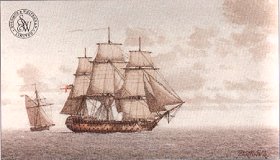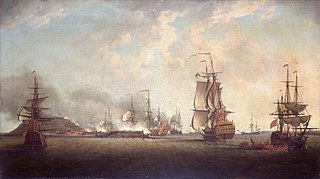HMS Ganges was a 74-gun third-rate ship of the line of the Royal Navy, launched in 1782 at Rotherhithe. She was the first ship of the Navy to bear the name, and was the name ship of her class. She saw active service from 1782 to 1811, in Europe and the West Indies.

HMS Barfleur was a 90-gun second-rate ship of the line of the Royal Navy, designed by Sir Thomas Slade on the lines of the 100-gun ship Royal William, and launched at Chatham Dockyard on 30 July 1768, at a cost of £49,222. In about 1780, she had another eight guns added to her quarterdeck, making her a 98-gun ship; she possessed a crew of approximately 750. Her design class sisters were the Prince George, Princess Royal, and Formidable. She was a ship of long service and many battles.

HMS Royal Oak was a 74-gun third-rate ship of the line of the Royal Navy, built by Jonas Shish at Deptford and launched in 1674. She was one of only three Royal Navy ships to be equipped with the Rupertinoe naval gun. Life aboard her when cruising in the Mediterranean Sea in 1679 is described in the diary of Henry Teonge.

HMS Fame was a 74-gun third-rate ship of the line of the Royal Navy, in service during the Seven Years' War and the American Revolutionary War.

HMS Raisonnable was a 64-gun third-rate ship of the line of the Royal Navy, named after the ship of the same name captured from the French in 1758. She was built at Chatham Dockyard, launched on 10 December 1768 and commissioned on 17 November 1770 under the command of Captain Maurice Suckling, Horatio Nelson's uncle. Raisonnable was built to the same lines as HMS Ardent, and was one of the seven ships forming the Ardent class of 1761. Raisonnable was the first ship in which Nelson served.

HMS Northumberland was a 74-gun third-rate ship of the line of the Royal Navy, built at the yards of Barnard, Deptford and launched on 2 February 1798. She carried Napoleon to his final exile on St Helena.

HMS Edgar was a 74-gun third-rate ship of the line of the Royal Navy, that saw service in the American Revolutionary, French Revolutionary and Napoleonic Wars. Launched in 1779, she fought in the battles of Cape St Vincent and Copenhagen, two of the major naval engagements of the wars.

HMS Hercules was a 74-gun third-rate ship of the line of the Royal Navy, designed by Sir Thomas Slade and built at Deptford Dockyard by Adam Hayes and launched on 15 March 1759.

HMS Edgar was a 60-gun fourth rate ship of the line of the Royal Navy, launched on 16 November 1758 at Rotherhithe. The physician Thomas Denman served on Edgar until 1763. She was sunk as a breakwater in 1774.

HMS Cambridge was an 80-gun third-rate ship of the line of the Royal Navy, designed by Sir Joseph Allin and built at Deptford Dockyard by Adam Hayes to the draught specified by the 1745 Establishment as amended in 1750, and launched on 21 October 1755.

HMS Caesar, also Cæsar, was an 80-gun third rate ship of the line of the Royal Navy, launched on 16 November 1793 at Plymouth. She was designed by Sir Edward Hunt, and was the only ship built to her draught. She was also one of only two British-built 80-gun ships of the period, the other being HMS Foudroyant.

HMS Prince was a 100-gun first rate ship of the line of the Royal Navy, built by Phineas Pett the Younger at Deptford Dockyard and launched in 1670.

The Foudroyant was an 80-gun ship of the line of the French Navy. She was later captured and served in the Royal Navy as the Third Rate HMS Foudroyant.

HMS Salisbury was a 50-gun fourth rate ship of the line of the Royal Navy, one of eight such ships authorised by the Navy Board on 24 December 1695 to be newly built ; the others were the Hampshire, Dartmouth, Winchester, Worcester, Jersey, Carlisle and Tilbury. The contract for the Winchester was signed with shipbuilders Richard and James Herring in 1696, for the ship to be built in their yard at Baileys Hard on the Beaulieu River in Hampshire, England, and she was launched there on 18 April 1698.

HMS Neptune was a 90-gun second-rate ship of the line of the Royal Navy. She was built under the 1677 "Thirty Great Ships" Programme and launched in 1683 at Deptford Dockyard.

HMS Essex was a 70-gun third rate built by Sir Henry Johnson of Blackwall in 1678/79. During the War of the English Succession she fought in the last major action. She was rebuilt in 1699/1700. During the War of Spanish Succession she fought at Vigo Bay, the Capture of Gibraltar and Velez Malaga. She also fought at the Battle off Passero in 1718. She was rebuilt again in 1736-40. She was in action off Toulon in 1744. She was active in the Channel and against French ports during the Seven Years War. She fought at Quiberon Bay in 1759. She was wrecked in Quiberon Bay in November 1759.

HMS Kingston was a 60-gun fourth-rate ship of the line of the Royal Navy, built by Frame in Hull and launched on 13 March 1697. She had an eventful career, taking part in numerous engagements.

HMS Berwick was a 70-gun third-rate ship of the line of the Royal Navy, built by Joseph Allin the younger to the 1733 proposals of the 1719 Establishment at Deptford Dockyard, and launched on 13 June 1743. It participated in the Battle of Toulon on 22–23 February 1744 under the command of Sir Edward Hawke.
HMS Burford was a 70-gun third rate ship of the line of the Royal Navy, built at Chatham Dockyard to the draught specified by the 1745 Establishment as amended in 1754, and launched in 1757.

HMS Sans Pareil("Without Equal") was an 80-gun third rate ship of the line of the Royal Navy. She was formerly the French ship Sans Pareil, but was captured in 1794 and spent the rest of her career in service with the British.


















